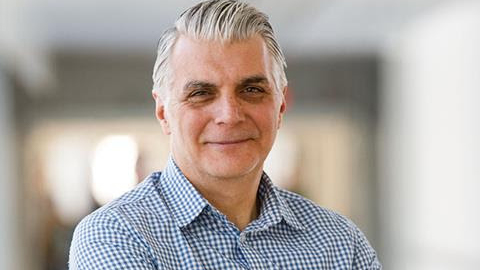Lifelong career in helping relieve patient pain inspired by researcher’s own childhood experience of migraine headaches
13 April 2023

Greg Kawchuk is a professor in the Department of Physical Therapy and his research focuses on disorders of the spine. He heads up a University of Alberta Rehabilitation Robotics Lab research team whose goal is to discover the causes of back pain and improve the quality of life for people experiencing back pain. His team is composed of an interdisciplinary group of researchers, undergraduate and graduate students, and postdoctoral fellows from several faculties: Rehabilitation Medicine, Medicine & Dentistry, Science and Engineering. Kawchuk is a member of the SMART network.
How did you get into your area of research?
I had a couple of years in my life where I experienced juvenile migraines. The standard treatment at the time was to get an injection that would knock you out for a few days. It was not a great way to be a kid. After a few years of that, my dad's best friend, who went to chiropractic college in Toronto, offered to help. I was really thankful for the relief chiropractic gave me, which started me toward a career in health care.
After a BSc in microbiology, I went to chiropractic school in Toronto, practised for 15 years, but was always frustrated by my clinical experiences. I would see two people who seemed very similar (sex, age, mechanism of injury) and even received the same treatment, but one got better and the other responded like nothing happened. That started me thinking about the underlying mechanisms of the problem and what might make someone a responder (or non-responder) to care. This interest led to a master’s in biomechanics and then that became a PhD in bioengineering, which then turned into a Canada Research Chair in Spinal Mechanics at the University of Alberta.
What kind of back pain were you most interested in?
It was not too long ago that many people perceived back pain as having a single specific cause, but we just hadn’t found it yet! We know now that back pain is most likely caused by a constellation of different problems, most of which are extremely difficult to identify in any given patient. Trying to understand the mechanisms that underlie back pain gives us the best chance at developing specific prevention, treatment and recovery strategies to identify who responds best and when. But in real life, people can't wait around for us to figure this out; they need something to help now even if the underlying mechanism is unknown and the intervention is not a cure. This is where the idea of managing low back pain as a chronic condition comes into play, something relatively new compared to even 10 years ago. And as a result, my research interests split off into other areas where we try to help people feel better with the best available evidence and programs, such as GLA:D Back, while we work out the underlying causes in the meantime.
How did you go from there to the Robotics Lab?
My lab has a pretty broad scope that encompasses animal studies, basic biomechanics, clinical trials, etc. This is because investigating both mechanisms and ways to manage back pain requires a lot of different methodologies and tools. Dr. Martin Ferguson-Pell, who shares laboratory space with me, also has very similar interests in developing solutions for people through various technologies. It’s been a great partnership. Together, we’ve combined these two research programs to create a unique kind of laboratory that can come up with innovative ways to tackle many types of musculoskeletal issues.
Now that you’re more advanced in your career, how do you find it differs from the early days?
At this point, my role in the lab is like being the coach of a sports team — something I did a lot of when my kids were young. What was really exciting about coaching was that circumstances would change constantly: someone would be injured, have to go to a family function, or the weather would change. And that was part of the fun — figuring out how to coach and provide a great experience for the kids with what you had. And as much as I love being on the ground level of research, stripping wires, coding, preparing tissues, etc., it’s also really exciting and rewarding to try to maximize what we can do with what we have as resources, people and opportunities that are constantly evolving.
If you were to give one piece of advice to your grad students what would it be?
I'm fortunate in that I’m involved with a lot of mentorship programs. What that experience has taught me is just how a mentoring experience differs from person to person. In mentoring, the key is being able to personalize the experience by understanding your mentees rather than having a one-size-fits-all approach. The challenge is trying to find that specific message for that specific person — just like treatment for back pain. So given that, I would tell my students to be part of that equation — to be ready for and open to change. Allow yourself to find that balance between sticking to your guns, acquiring new skills and experiences, and when to move on.
If you could have a profession other than your own, what would you want to do?
That’s a really hard question. If I could though, I think it would be exciting to engulf myself in something absolutely new, then move on to something completely different. I love trying new things, so I guess there could easily be 10 different answers for the next 10 years. That’s why I love research — there are so many different things to do in the day, new skills to acquire and new challenges to solve.